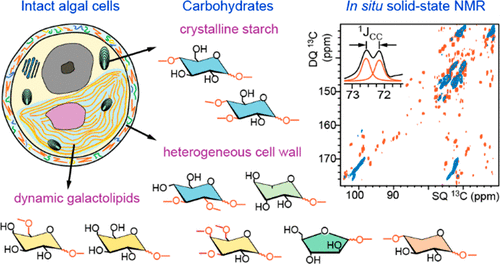当前位置:
X-MOL 学术
›
J. Am. Chem. Soc.
›
论文详情
Our official English website, www.x-mol.net, welcomes your feedback! (Note: you will need to create a separate account there.)
Identification and Quantification of Glycans in Whole Cells: Architecture of Microalgal Polysaccharides Described by Solid-State Nuclear Magnetic Resonance
Journal of the American Chemical Society ( IF 15.0 ) Pub Date : 2021-11-04 , DOI: 10.1021/jacs.1c07429 Alexandre Poulhazan 1 , Malitha C Dickwella Widanage 2 , Artur Muszyński 3 , Alexandre A Arnold 1 , Dror E Warschawski 4 , Parastoo Azadi 3 , Isabelle Marcotte 1 , Tuo Wang 2
Journal of the American Chemical Society ( IF 15.0 ) Pub Date : 2021-11-04 , DOI: 10.1021/jacs.1c07429 Alexandre Poulhazan 1 , Malitha C Dickwella Widanage 2 , Artur Muszyński 3 , Alexandre A Arnold 1 , Dror E Warschawski 4 , Parastoo Azadi 3 , Isabelle Marcotte 1 , Tuo Wang 2
Affiliation

|
Microalgae are photosynthetic organisms widely distributed in nature and serve as a sustainable source of bioproducts. Their carbohydrate components are also promising candidates for bioenergy production and bioremediation, but the structural characterization of these heterogeneous polymers in cells remains a formidable problem. Here we present a widely applicable protocol for identifying and quantifying the glycan content using magic-angle-spinning (MAS) solid-state NMR (ssNMR) spectroscopy, with validation from glycosyl linkage and composition analysis deduced from mass-spectrometry (MS). Two-dimensional 13C–13C correlation ssNMR spectra of a uniformly 13C-labeled green microalga Parachlorella beijerinckii reveal that starch is the most abundant polysaccharide in a naturally cellulose-deficient strain, and this polymer adopts a well-organized and highly rigid structure in the cell. Some xyloses are present in both the mobile and rigid domains of the cell wall, with their chemical shifts partially aligned with the flat-ribbon 2-fold xylan identified in plants. Surprisingly, most other carbohydrates are largely mobile, regardless of their distribution in glycolipids or cell walls. These structural insights correlate with the high digestibility of this cellulose-deficient strain, and the in-cell ssNMR methods will facilitate the investigations of other economically important algae species.
中文翻译:

全细胞中聚糖的鉴定和定量:固态核磁共振描述的微藻多糖结构
微藻是广泛分布在自然界中的光合生物,可作为生物产品的可持续来源。它们的碳水化合物成分也是生物能源生产和生物修复的有希望的候选者,但这些异质聚合物在细胞中的结构表征仍然是一个令人生畏的问题。在这里,我们提出了一种广泛适用的协议,用于使用魔角旋转 (MAS) 固态核磁共振 (ssNMR) 光谱识别和量化聚糖含量,并通过质谱 (MS) 推导出的糖基连接和成分分析进行验证。均匀13 C 标记的绿色微藻Parachlorella beijerinckii的二维13 C– 13 C 相关 ssNMR 光谱揭示淀粉是天然纤维素缺陷菌株中最丰富的多糖,并且这种聚合物在细胞中采用组织良好且高度刚性的结构。一些木糖存在于细胞壁的移动和刚性结构域中,它们的化学位移与植物中鉴定的扁平带状 2 倍木聚糖部分对齐。令人惊讶的是,大多数其他碳水化合物在很大程度上是可移动的,无论它们在糖脂或细胞壁中的分布如何。这些结构见解与这种缺乏纤维素的菌株的高消化率相关,细胞内 ssNMR 方法将有助于对其他经济上重要的藻类物种的研究。
更新日期:2021-11-24
中文翻译:

全细胞中聚糖的鉴定和定量:固态核磁共振描述的微藻多糖结构
微藻是广泛分布在自然界中的光合生物,可作为生物产品的可持续来源。它们的碳水化合物成分也是生物能源生产和生物修复的有希望的候选者,但这些异质聚合物在细胞中的结构表征仍然是一个令人生畏的问题。在这里,我们提出了一种广泛适用的协议,用于使用魔角旋转 (MAS) 固态核磁共振 (ssNMR) 光谱识别和量化聚糖含量,并通过质谱 (MS) 推导出的糖基连接和成分分析进行验证。均匀13 C 标记的绿色微藻Parachlorella beijerinckii的二维13 C– 13 C 相关 ssNMR 光谱揭示淀粉是天然纤维素缺陷菌株中最丰富的多糖,并且这种聚合物在细胞中采用组织良好且高度刚性的结构。一些木糖存在于细胞壁的移动和刚性结构域中,它们的化学位移与植物中鉴定的扁平带状 2 倍木聚糖部分对齐。令人惊讶的是,大多数其他碳水化合物在很大程度上是可移动的,无论它们在糖脂或细胞壁中的分布如何。这些结构见解与这种缺乏纤维素的菌株的高消化率相关,细胞内 ssNMR 方法将有助于对其他经济上重要的藻类物种的研究。


























 京公网安备 11010802027423号
京公网安备 11010802027423号